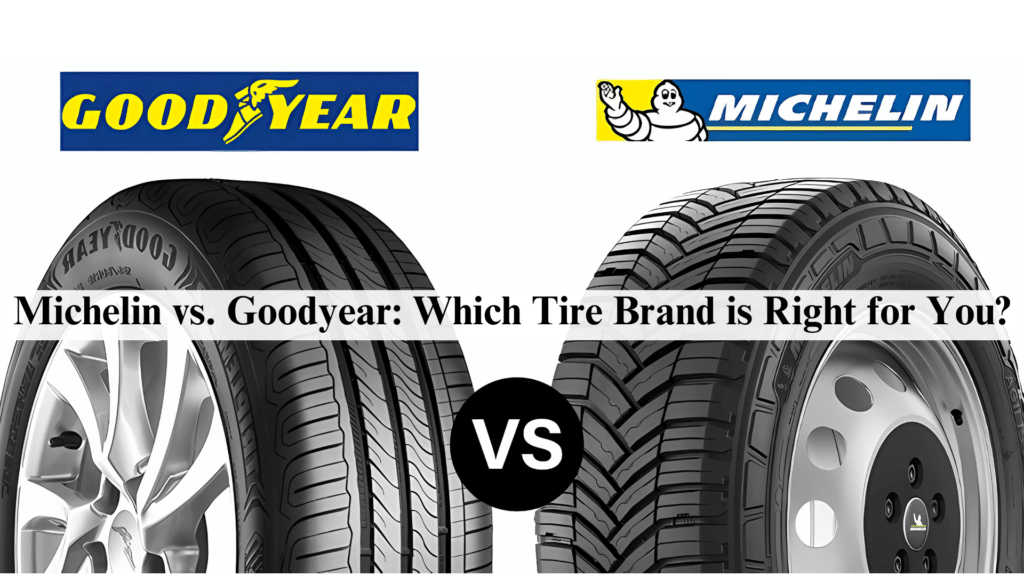Choosing between Michelin and Goodyear feels like a real headache, right? I get it – you want tires that’ll keep your family safe without emptying your wallet.
I’ve spent 15 years working at tire shops and testing both brands on everything from family sedans to heavy-duty trucks. In this guide, I’ll help you understand exactly what each brand does best – from performance and durability to cost and warranty coverage.
You’ll discover which tire brand makes the most sense for your specific needs, whether you’re commuting on highways, tackling tough winter roads, or looking for the best value for your money.
No marketing fluff or complicated jargon here. Just honest, practical advice from someone who’s mounted thousands of tires and heard real feedback from drivers like you.
Overview of Michelin and Goodyear

Let me break down these two tire giants for you in plain English.
Michelin
Started in France back in 1889. Today, they’re known for making premium tires that tend to cost more but often last longer. Think of them as the luxury car of tires – you’ll pay extra, but you’re getting top-notch quality.
Goodyear
Born in Ohio in 1898, is America’s homegrown tire champion. They focus on making reliable tires that won’t break your bank. Picture Goodyear as your dependable pickup truck – not the fanciest option, but it gets the job done well.
Here’s what makes each brand special:
Michelin shines with:
- Super-quiet rides
- Excellent wet-road grip
- Long-lasting tread life
- Advanced tire technology
Goodyear stands out for:
- Great value for money
- Strong winter performance
- Wide variety of options
- Solid everyday reliability
I’ve noticed that Michelin typically edges out Goodyear in professional tests, but Goodyear often delivers 80% of Michelin’s performance at a much better price.
The choice really depends on what matters most to you – premium performance or solid value.
Take my friend Mike, for example. He drives 50 miles each day for work and chose Michelin for their longer life. But my neighbor Sarah, who drives mostly around town, went with Goodyear and couldn’t be happier with the savings.
Key Features Comparison: Michelin Vs. Goodyear
Performance & Handling
- Michelin: Superior grip on dry roads, exceptional cornering stability, better high-speed performance
- Goodyear: Good all-around grip, reliable handling, strong performance in everyday driving conditions
Wet Weather Performance
- Michelin: Best-in-class hydroplaning resistance, excellent wet braking, superior wet traction
- Goodyear: Solid wet-weather grip, dependable wet braking distances, effective water evacuation
Winter Performance
- Michelin: Strong ice traction, reliable snow performance, good cold-weather flexibility
- Goodyear: Excellent snow grip, superior ice handling, better deep-snow performance in many tests
Tread Life
- Michelin: Typically lasts 70,000-80,000 miles on passenger tires
- Goodyear: Usually offers 60,000-70,000 miles on comparable models
Price Point
- Michelin: Higher initial cost ($150-300 per tire for passenger vehicles)
- Goodyear: More affordable ($120-250 per tire for passenger vehicles)
Warranty Coverage
- Michelin: 6-year standard warranty, includes road hazard for first year
- Goodyear: 6-year standard warranty, optional road hazard coverage available
Noise Level
- Michelin: Quieter ride, less road noise at highway speeds
- Goodyear: Average road noise, slightly louder on rough surfaces
Available Models
- Michelin: Fewer options but more specialized designs
- Goodyear: Wider range of models across all price points
Tire Categories and Popular Models
| Tire Category | Model | Price Range | Best For | Standout Feature |
|---|---|---|---|---|
| All-Season Passenger Tires | Michelin Defender T+H | $135-180 | Daily commuters, family sedans | 80,000-mile warranty |
| Goodyear Assurance All-Season | $110-150 | Budget-conscious drivers | Reliable year-round performance | |
| Performance Tires | Michelin Pilot Sport 4S | $200-300 | Sports cars, performance enthusiasts | Exceptional handling and grip |
| Goodyear Eagle F1 | $180-250 | Performance on a budget | Great wet-weather handling | |
| SUV/Truck Tires | Michelin Defender LTX | $190-250 | Luxury SUVs, light trucks | Quiet ride, long tread life |
| Goodyear Wrangler | $160-220 | All-terrain use, work trucks | Tough construction | |
| Winter Tires | Michelin X-Ice | $160-220 | Severe winter conditions | Superior ice performance |
| Goodyear WinterCommand | $140-190 | Snow and slush | Excellent deep snow traction | |
| Touring Tires | Michelin Premier A/S | $160-210 | Luxury sedans, comfort-focused drivers | Exceptional comfort |
| Goodyear ComfortDrive | $140-190 | Smooth, quiet rides | Good balance of comfort and durability |
Pros and Cons of Each Brand
Michelin
Pros:
- Exceptional tread life – most tires last 20% longer than competitors
- Superior handling in both wet and dry conditions
- Quieter ride across all surfaces
- Better fuel efficiency due to lower rolling resistance
- Premium materials and build quality
- Stronger resale value for your vehicle
- More consistent performance throughout tire life
Cons:
- Significantly higher upfront cost
- Limited options in budget tire categories
- Fewer models for specific vehicle types
- Less aggressive tread patterns for off-road use
- Premium prices can be hard to justify for low-mileage drivers
- Limited availability in some regions
Goodyear
Pros:
- Better value for money
- Excellent winter performance across their lineup
- Wide range of models for every budget
- Strong off-road tire options
- More readily available nationwide
- Frequent sales and promotions
- Good selection of specialized tires
Cons:
- Shorter tread life compared to Michelin
- Slightly noisier on highway drives
- Less refined ride quality
- Lower fuel efficiency in most models
- Performance drops off faster as tires wear
Basic models may need more frequent rotation
Price and Value Comparison
Initial Cost Breakdown
- Michelin passenger tires: $135-300 per tire
- Goodyear passenger tires: $110-250 per tire
- Average price difference: $25-50 per tire higher for Michelin
Cost Per Mile
Michelin Example
- Average cost: $200 per tire
- Typical lifespan: 75,000 miles
- Cost per mile: 0.27 cents
Goodyear Example
- Average cost: $160 per tire
- Typical lifespan: 65,000 miles
- Cost per mile: 0.25 cents
Long-Term Value Factors
Fuel Savings
- Michelin: Saves roughly $50-75 annually in fuel costs
- Goodyear: Standard fuel efficiency, minimal savings
Maintenance Needs
- Michelin: Rotation every 7,500-8,000 miles
- Goodyear: Rotation needed every 6,000-7,000 miles
Replacement Timeline
- Michelin: Usually needs replacement every 6-7 years
- Goodyear: Typically needs replacement every 5-6 years
Hidden Costs to Consider
- Alignment requirements
- Rotation costs ($20-40 per service)
- Balancing needs ($40-80 per set)
- Road hazard warranty costs
- Installation fees ($15-30 per tire)
Real-World Example:
- Michelin total cost: ~$1,000 (including maintenance)
- Goodyear total cost: ~$950 (including more frequent maintenance)
The difference in long-term costs isn’t as big as the initial price gap suggests. Michelin’s higher upfront cost is partially offset by longer life and better fuel economy.
Michelin vs. Goodyear: Which is Right for You?
Choose Michelin if:
- You drive more than 15,000 miles annually
- Your priority is long-term durability
- You own a luxury or high-performance vehicle
- Fuel efficiency matters to you
- You want the quietest possible ride
- You’re willing to pay more upfront for quality
- You keep your cars for 5+ years
Choose Goodyear if:
- You drive less than 15,000 miles per year
- You’re working with a tighter budget
- You need all-terrain or off-road options
- Winter performance is your top priority
- You want more model choices
- You replace your car every 3-4 years
- You prioritize initial cost savings
Real-World Scenarios
The Highway Commuter If you’re driving 50+ miles daily, Michelin’s better fuel efficiency and longer tread life make them worth the extra cost.
The City Driver For mainly city driving with lower annual mileage, Goodyear offers better value without sacrificing needed performance.
The Family SUV Both brands work well, but Goodyear often provides better value for family vehicles that see moderate use.
The Performance Car Michelin’s superior handling and grip make them the clear choice for sports cars and performance vehicles.
Remember: The “right” choice depends on your specific needs, driving habits, and budget. Don’t just focus on the brand name – consider your actual driving conditions and how long you plan to keep your tires.
Conclusion
Choosing between Michelin and Goodyear doesn’t have to be overwhelming. While Michelin leads in premium performance, longevity, and refinement, Goodyear delivers reliable quality at a more accessible price point.
From my years of experience, both brands make excellent tires – they just serve different needs and priorities.
Think about your driving habits, budget, and what matters most to you. If you’re racking up serious miles or want the absolute best performance, Michelin’s higher price tag often pays for itself through longer life and better fuel economy.
But if you’re seeking solid, dependable tires that won’t break the bank, Goodyear offers impressive value and capability.
Remember, there’s no wrong choice here. Both brands have earned their reputations through decades of proven performance. Focus on matching the tire to your specific needs rather than just the name on the sidewall.
Whether you choose the premium route with Michelin or the value proposition of Goodyear, you’ll be getting a quality product from a trusted manufacturer.
The best tire for you is the one that matches your driving style, vehicle needs, and budget while delivering the performance and peace of mind you expect.
Frequently Asked Questions
Are Michelin tires really worth the extra money?
It depends on your driving habits. If you drive more than 15,000 miles yearly, Michelin’s longer tread life and better fuel efficiency often justify the higher cost. For lower-mileage drivers, the premium price might not be worth it.
Do Goodyear tires last as long as Michelin?
Generally, Michelin tires last about 10-15% longer than comparable Goodyear models. While a typical Michelin tire might last 75,000 miles, a similar Goodyear tire usually lasts around 65,000 miles.
Which brand is better in snow and rain?
Both perform well, but they have different strengths. Goodyear typically edges out Michelin in snow performance, while Michelin usually offers better wet-road handling and hydroplaning resistance.
Can I mix Michelin and Goodyear tires on my car?
While it’s technically possible, it’s not recommended. Using different tire brands can lead to uneven handling and wear. Always install the same type of tires across all wheels.
Which brand offers better warranties?
Both offer similar 6-year warranty coverage. Michelin includes first-year road hazard protection, while Goodyear offers it as an optional add-on.
How often do I need to rotate each brand?
Michelin recommends rotation every 7,500-8,000 miles, while Goodyear suggests every 6,000-7,000 miles. Following these guidelines helps ensure even wear and optimal performance.
Do either brand’s tires improve gas mileage?
Yes. Michelin tires generally offer lower rolling resistance, which can improve fuel economy by 1-2%. Goodyear tires provide standard fuel efficiency in line with industry averages.
Which brand is better for SUVs and trucks?
Both excel here. Michelin offers better on-road comfort and longevity, while Goodyear provides more options for off-road use and typically costs less.
How do I know if the tires I’m buying are fresh?
Check the DOT code on the sidewall. The last four numbers show the manufacturing date (week/year). Both brands recommend using tires less than 5 years old from the manufacture date.


